EIME
EIME Project (merging Early Intervention and Mechanical Engineering) EIME website
Dr. Canfield initiated the EIME website project (EIME website) at Tennessee Technological University in 1999. The theme of the EIME program is to implement, demonstrate and assess a model for contextual learning in a junior-level mechanism design course that emphasizes real-world applications in developing specialized assistive devices (machines) for children with special needs. This project is called merging Early Intervention and Mechanical Engineering (EIME) because it grew out of a collaboration between Mechanical Engineering and Early Intervention, both located on campus at Tennessee Tech. The project pairs engineering student teams from ME 3610 (Kinematics and Dynamics of Machinery) with assistive technology needs for children with disabilities in the Upper-Cumberland Region of Tennessee. The student teams are supported by educational, service and medical professionals located in the region along with the child’s family. They form a larger multi-disciplinary team to address the child’s assistive technology needs. The larger group supports the student team to provide necessary input in defining and addressing the need while the student team carries out the project design from early stage conceptual design through overseeing fabrication, testing and implementation. This project provides a strong hands-on component to the mechanism design class at TTU and provides a multi-disciplinary project activity for our students.
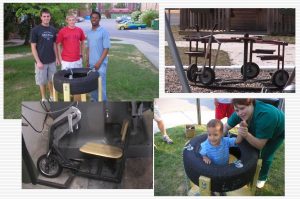
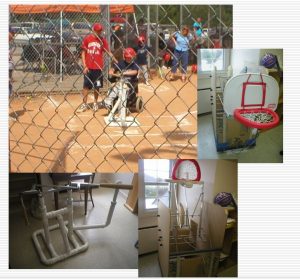
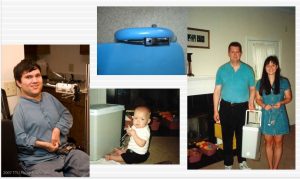
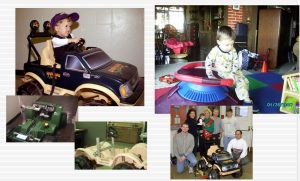
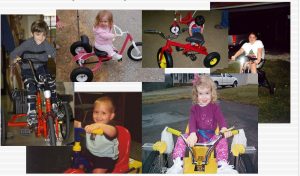
Projects by Semester:
2012 – Fall
Prior years: http://www.cae.tntech.edu/~scanfield/EIME/EIME%20web/myweb/Product%20Catalog.htm
Impact of EIME Project to date:
- Impact on TTU students:
- over 1000 students engaged in project activities
- Impact on Children and Families in TN:
- served over 200 family/children needs
- 10+ school systems
- Developmental, inclusion, transition, play
- Potential financial impact on our community, TN:
- $91k/yr approximated contribution, $600+k over relationship with TN dept. of special ed.
- Impact on other engineering programs
- Replicated at 2+ institutions in TN
Evidence of Community Collaboration for Change
This project grew out of an identified need in providing educational and developmental services to children with special needs in a largely rural region of the Upper Cumberland region in Middle Tennessee. This need was typified in the early-intervention directive, the IDEA Part C mandate, to establish a family-centered process for meeting the needs of children, at the stages of assistive and adaptive technology needs. Due to numerous pressures, the resources for such mandates are likely to become increasingly limited at a state and local level for such activities and, without supports, the process tends to revert to a clinical approach. The originating goal of this project was to extend this family-centered approach through all stages of the IFSP, particularly in the areas of assistive / adaptive technology in a sustainable manner by developing strong collaboration with external resources, such as engineering or technical education, to provide a significant means to extend these limited resources by mining the creative and design skills that engineering students at mid to upper levels of their undergraduate program possess. This initiative has provided a significant value-added component to the current early intervention system and through proper demonstration will form a sustainable system in which multiple constituents are involved (families, fathers, engineering students, etc.) and are contributing and receiving benefit from this model.
This project has created a model of formal collaboration that teams multiple resources commonly available to early interventionists but often under-utilized, to enhance services with respect to technology. These resources include availability of engineering and technical expertise of students at local universities, active engagement of fathers, and information assistance and sharing among families in a “community.” The originating mission of my EIME project is to significantly enhance the existing Part C service delivery system in such a way that will add to the National understanding of how to better carryout our mandate for using technology to serve infants and toddlers with special needs and their families. This Project provides a value-added initiative to our State’s system, with demonstrated sustainability that accomplishes this mission through the following three overriding goals:
- To implement, evaluate and disseminate a model that applies a family-centered approach (with a particular emphasis on fathers) to the plan, design and use of adaptive and assistive technology to infants and toddlers with disabilities.
- To formalize and evaluate a process of sustainable collaboration with university-level engineering education to serve as a resource to help meet the technology needs of children with disabilities and their families.
- To demonstrate both sustainability of the model and a value-added element to the state of Tennessee’s early intervention delivery system, and other Part C settings.
The project has grown in scope and size to target needs for children with disabilities at both the early intervention and school system ages.
Evidence of Engaged High-quality Academic Work.
The contribution to provide personalized assistive technology to children in our community represents just one side of the EIME project. The other side is to contribute to improving the model for engineering education. There has been a significant emphasis in engineering education programs to enhance students’ learning experience through a focus on the context in which learning takes place1. The idea itself is not new, and in fact, may have been a more typical way of learning an advanced technical trade in earlier times. However, the approach is being revisited in many ways under different descriptions, each emphasizing a particular aspect of how providing a realistic and motivational environment for the teaching process can enhance learning. Some examples include open ended design problems2, service learning activities3, problem-solving-based learning4 and multi-disciplinary teaming5. These methods suggest and reinforce the notion that contextual learning is an effective and important tool and form a pedagogical basis for the EIME project.
There are four primary educational objectives for the EIME project: 1) To engage students in a real-world application of mechanism design, 2) to provide a compelling and immediate purpose for learning mechanism theory, 3) to provide students experience in working with customers (and other team members) that are not engineers and 4) to create an opportunity for students to see their design in practice and learn from this experience.
Dr. Canfield initiated this project very early in his teaching career at TTU, based on a simple idea that students learn by doing. The innovations for this project have been a process of evolution over time and consist of the following: 1) Forming a community support team that provide appropriate project needs and are willing to work with the students (his class addresses 6-10 needs a semester), 2) securing resources to fund project fabrication and testing, 3) providing course learning material in an asynchronous manner, through online access to course materials, example problems, recorded course lectures, 4) providing a framework to guide the students through the design process 5) providing timely feedback to the students during the design and fabrication process including two formal design reviews in front of practicing engineers and 6) a guided reflection stage at the end of the project to engage students in a review and assessment of their learning and project impacts and outcomes.
Dr. Canfield regularly assesses and adjusts the project to better meet its educational objectives. The primary assessment tools are student input through project surveys, student performance on mechanism design tasks as measured by feedback from the families and professionals that receive the project results and topic-level performance on the FE exam. Historical evidence and assessment data show that my EIME program is regularly meeting its stated objectives. The students, College and community are equal collaborators that support and make the project possible.
Dr. Canfield started the EIME project at TTU in 1999. The project began as a collaboration with a senior faculty in the College of Education and Dr. Canfield’s students, which led toward a focus on children with special needs. The project gradually grew over time to become a regular part of the mechanism design coursework and now involves 60-70 students each year. Dr. Canfield has recruited several other colleagues in my College to participate in this project, for example a cooperation with a freshman level introduction to engineering design class allows freshman students to interact with junior level students on these design projects. ME 3610 is offered as a classic mechanisms class covering the fundamentals of kinematics, analysis and synthesis of linkages, cams and gear systems, and some basic force analysis, mechanical advantage and the method of virtual work.
The Learning Activities and Materials Developed
Dr. Canfield’s educational innovation requires a combination of support materials external to the curriculum as well as curricular materials. The external support materials consist of two primary components; 1) A source of projects and support in coordinating and providing guidance on these projects. These come from a community support team that I have established consisting of local therapists, interventionists and medical personnel. They provide the assistive technology needs and are willing to work with the students. 2) Financial resources to fund project fabrication and testing, which has been a combination of support through the state of TN department of special education, the College of Engineering at TTU and local businesses and donors. Typical projects cost $300-$600.
The curricular and instruction support materials that Dr. Canfield has developed consist of several components; 1) a means to provide course learning material in an asynchronous manner, since the projects are open-ended and start on the first day of the semester. This has been done through online access to all course materials including example problems with solutions and homework with immediate feedback, recording all lectures online and making lectures available from past courses. These allow students to move into course topics at their own pace as needed and free up class time for more discussion of mechanism applications through the current projects. 2) A framework to guide the students through the design process, which is done primarily through having students record and report all of their project developments on a project wiki, the wiki starts with a template showing them key outcomes they must meet in their project. 3) Two formal design reviews in front of practicing engineers and faculty to provide feedback during the design and implementation process.
The project needs are presented to student teams on the first day of class to set the context for the entire course. The students begin their work on the project simultaneously as the course proceeds through the topic material. Students perform a conceptual design, a review, a final design, a review, and then construct, review and deliver the project to the family. The project concludes with reflection by student teams of their work on the project and how their thinking and skill sets have changed over the course of this experience.
Evidence of Institutional Impact
Under Dr. Canfield’s leadership, the EIME project has grown from an informal collaboration started with the Department of Curriculum and Instruction to include teaming with numerous departments within the College of Engineering at TTU, The Tennessee Early Intervention System (TEIS), Children Special Services (CSS), County school systems in the Upper Cumberland Region of Tennessee and support from the Tennessee’s Department of Special Education. Over 900 students have gone through the EIME project with over 125 assistive mechanisms delivered to families. Many of these students have cited this experience as a key decision to stay in engineering studies or to choose particular career fields within engineering.
The EIME project has been recognized as an exemplary program by the institution (TTU) and is part of a leadership effort for influencing curriculum across campus through the QEP (Quality Enhancement Program). Dr. Canfield regularly mentors other faculty in issues related to integrating curriculum and community service programs. These issues include curriculum development, time management, liability and obtaining financial support for sustainable contributions.
The project is now serving as a model for other engineering programs across the state of Tennessee where its application is being replicated. Two examples are the University of Tennessee Chattanooga and the University of Tennessee Martin.
The project results are shared online to encourage others to replicate individual projects given a set of design plans. EIME projects for the past three years can be found online at http://ttu-eime.csc.tntech.edu/index.php/Main_Page and for the past six years at http://eime.wikidot.com/
- McKeachie, W. J and B. K. Hofer, McKeachie’s Teaching Tips: Strategies, Research and Theory for College and University Teachers, 2002.
- Dan McGraw, “Expanding the Mind,” ASEE Prism, Vol. 13, No. 9, 2004.
- Oakes,,W., Duffy, J., Jacobius, T., Linos, P., Lord, S., Schultz, W., and A. Smith, “Service Learning in Engineering,”,ASEE,FIE 2002.
- 4. Duch, B. J., “Models for Problem-Based Instruction in Undergraduate Courses,” Ch. 4 The Power of Problem-Based …2001, pp. 39 – 44.
- Mourtos, N.J., “The Nuts and Bolts of Cooperative Learning in Engineering,” Journal of Engineering Education, ASEE, January 1997, pp. 35-37.
